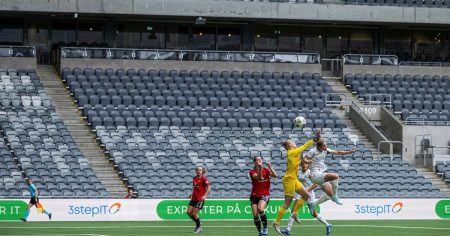Arsenal’s recent match against Fulham highlighted their continued reliance on set-pieces, particularly corner kicks, for offensive production. While they managed to salvage a 1-1 draw thanks to a corner-kick routine that resulted in William Saliba’s equalizer, their overall performance raised concerns about their ability to create scoring opportunities from open play. This dependence on set-pieces, while effective at times, can be a double-edged sword, as it makes their attack predictable and susceptible to disruption by opponents who can anticipate and defend against these set plays.
The statistics underscore Arsenal’s proficiency from corners. Since the start of the previous season, they have scored an impressive 23 goals from corner kicks, a league-leading figure across Europe’s top five leagues. This remarkable statistic speaks volumes about their well-drilled routines, the aerial prowess of their players, and the quality of their delivery. However, it also masks a potential weakness – an over-reliance on these situations to generate goals. A team aspiring to challenge for major honors needs a more diversified attacking approach, capable of breaking down defenses through various methods, not just set-pieces.
Against Fulham, Arsenal demonstrated their vulnerability when their open-play opportunities were limited. While Bukayo Saka’s disallowed goal in the closing stages showcased a glimpse of their potential in open play, the subsequent VAR review and offside call underscored their struggles to consistently create and finish such chances. This reliance on set-pieces, while providing a valuable scoring avenue, can limit their overall attacking threat, especially against well-organized defenses that effectively neutralize their corner-kick strategies.
The match also exposed Arsenal’s need for greater creativity and penetration in their build-up play. They often struggled to unlock Fulham’s defense, resorting to predictable passing patterns and lacking the incisiveness required to create clear-cut chances. This lack of dynamism in their offensive play is a concern, particularly against teams that sit deep and defend compactly. Over-reliance on set-pieces can be a crutch, masking underlying deficiencies in creating opportunities from open play. To compete at the highest level, Arsenal must develop a more multi-faceted attacking approach.
Furthermore, the draw against Fulham left Arsenal six points adrift of league leaders Liverpool, who also have a game in hand. This early deficit in the season underscores the importance of maximizing points in every match. While Arsenal’s resilience and ability to salvage a draw from a difficult situation is commendable, their inability to secure all three points against a team considered to be weaker on paper highlights the need for improvement. Their dependence on set-pieces, while effective in this particular match, cannot be their sole reliance if they are to close the gap on the league leaders and mount a serious title challenge.
In conclusion, Arsenal’s performance against Fulham, while resulting in a draw, exposed their over-reliance on set-pieces and their struggles to create consistent scoring opportunities from open play. While their proficiency from corner kicks is undeniable, their dependence on this aspect of their game can be a limiting factor. To truly compete with the top teams and challenge for the title, Arsenal must diversify their attacking approach, improve their build-up play, and find more consistent ways to unlock stubborn defenses. Their current reliance on set-pieces, while valuable, cannot be their sole source of goals if they aim to achieve sustained success.














